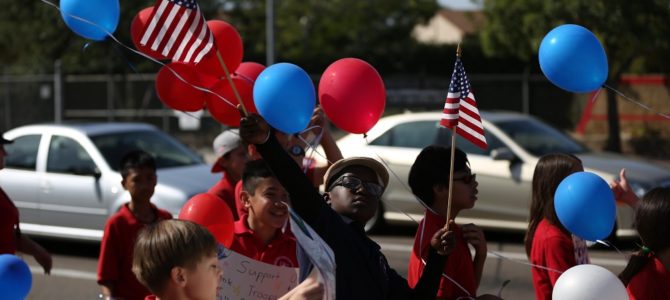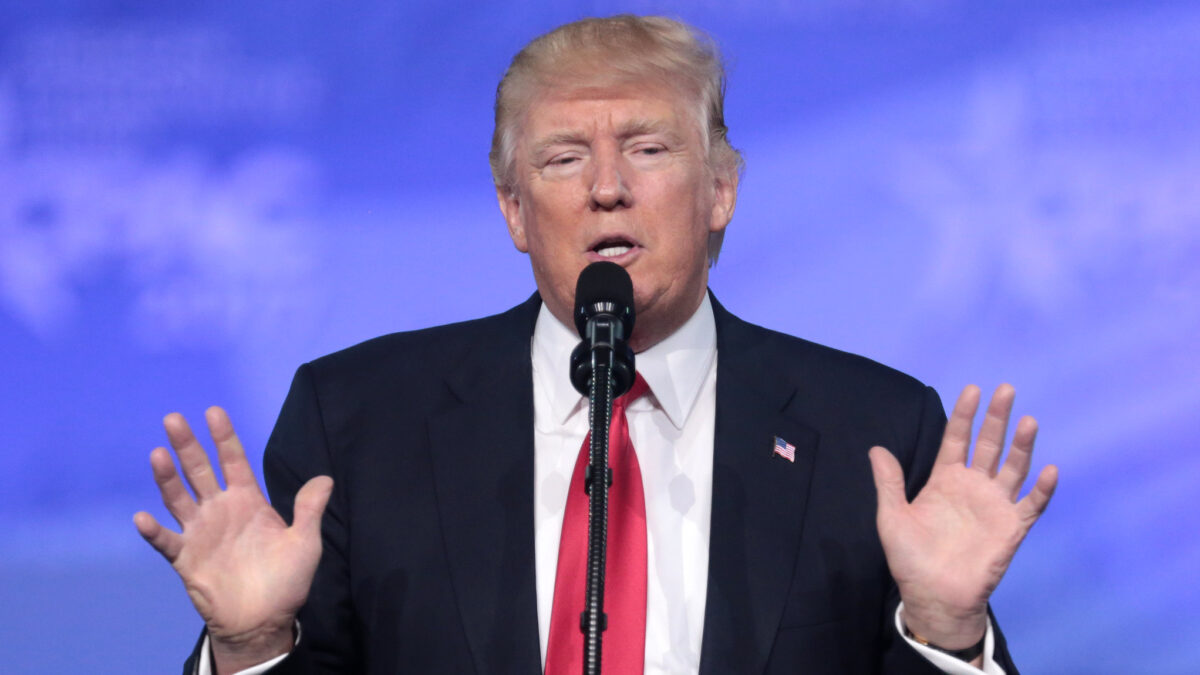
After two centuries of debate, discrimination, and political fights, a handful of Montana parents have succeeded in putting state constitutional Blaine Amendments squarely in front of the U.S. Supreme Court. The court is now poised to settle one of the most pressing issues in American education and issue perhaps the most important education-related ruling since Brown v. Board of Education.
The road to this point has been a long one, full of twists and turns and enough unsavory politics to make even 2019 America look tame. As we approach what many pray will be a watershed moment on the question of religious discrimination in K-12 choice programs, it’s worth looking back and remembering how we got here.
What Is a Blaine Amendment?
Although some clauses originated earlier, the main plotline of the Blaine saga began ahead of the 1876 presidential election. Civil War hero Ulysses S. Grant was president. His administration was floundering under numerous scandals, and the nation was shuddering through a severe economic downturn.
Meanwhile, Democrats in the post-Reconstruction South were flexing their political muscle. Their party had seized 94 seats and control of the U.S. House of Representatives in 1874, as well as a significant number of U.S. Senate seats. Given the Grant administration’s troubles, it looked as if Democrats might also capture the White House in 1876.
If Republicans were going to survive the 1876 elections, they needed something to energize key groups of voters, and there were few groups as key at that time as nativist Protestants. A wave of mostly Catholic immigration from European countries in the mid-19th century had sparked fears about the influence of foreign “papists” on American society, and a significant block of voters were prepared to cast their ballots in response to these fears.
Anti-Catholic, anti-immigrant sentiment spilled into a debate about public support for parochial schools, known then as the “School Question.” Debates over taxpayer funding for parochial schools had raged for decades before Grant’s political gambit, driven mostly by Catholics who sought funding for their schools after fleeing the pervasively Protestant and largely anti-Catholic curricula and practices in early public schools.
In at least some instances, debates over religion in school had turned violent. The Nativist Riots of 1844, sparked by a Catholic challenge to Bible-reading in public schools, saw 20 people killed, hundreds injured, and Catholic churches and convents burned.
In other cases, the damage was political. Thanks in part to his decision to support public funding for Catholic schools in New York during his governorship in the 1840s, William H. Seward lost the 1860 Republican presidential nomination to a relatively unknown Illinois lawyer named Abraham Lincoln.
Weaponizing Anti-Religious Bigotry
It was against this historical backdrop that President Grant delivered his famous 1875 speech in favor of permanent restrictions on funding for “sectarian” schools. The speech was carefully crafted to win support from nativist factions for the Republican Party, and Grant’s political intentions were widely recognized at the time.
One of those who smelled what Grant was cooking was Maine Rep. James G. Blaine. Blaine, a Republican, had lost his position as speaker of the House during the 1874 Democratic landslide. He now set his sights on the White House.
Seeking any means of strengthening his chances to win the 1876 Republican nomination for president, Blaine seized on the opportunity provided by Grant’s speech by proposing an amendment to the U.S. Constitution that would forever bar aid to “sectarian” institutions. At that time, “sectarian” was a pejorative used to denote heresy or beliefs that deviated from mainstream Protestantism. In particular, most understood the word to be a euphemism for “Catholic.”
Blaine’s amendment ultimately failed, as did his bid for the presidency. Rutherford B. Hayes, who had also leaned on anti-Catholic sentiment as governor of Ohio, won the nomination and eventually the presidency.
Since he was raised by a Catholic mother, Blaine was very likely not anti-Catholic. After it failed to secure him the presidential nomination, he seemed to lose all serious interest in the School Question. Tellingly, he neglected even to mention his famous amendment in his own autobiography. But the deliberate inflammation of public passions in the name of political ambition often comes at a price, and the price in this case was further reinvigoration of the debates over “sectarian” schools.
States Rush to Make Public Schools All Protestant
Blaine’s lack of interest did little to slow down the adoption of similar language as new states ratified their constitutions and joined the Union. New states sensed the same wave of public sentiment that Grant and Blaine sought to harness, and likely understood the dangers of interfering with political strategy while applying for statehood. When all was said and done, “Blaine Amendments” could be found in more than three dozen state constitutions across America.
Modern advocates will be more familiar with the story from here. Fights over aid for “sectarian” schools were renewed in earnest in the late 20th century as several states adopted the first crop of modern private school scholarship programs. The meaning of “sectarian” had switched, however, from a stand-in for Catholic to being a stand-in for any religiously oriented school at all as public schools lost their Protestant character in favor of secularism. The U.S. Supreme Court upheld state scholarship programs under the First Amendment in the 2002 Zelman ruling, which held that voucher programs maintained the required level of government neutrality toward religion by providing aid to parents who made independent decisions about where to use it.
Even with the federal constitutional issues settled, however, battles continued to rage under state constitutional language. Enter Douglas County, Colorado, where a local school board adopted the nation’s first district-level K-12 voucher program. The program was struck down by the Colorado Supreme Court under the state’s Blaine Amendment after years of heated litigation, at which point the district appealed the issue to the U.S. Supreme Court in 2017.
Having issued a narrower decision on the Blaine issue in Trinity Lutheran, SCOTUS essentially punted the case back to the Colorado Supreme Court for further consideration. SCOTUS made its decision to (again) sidestep the Blaine issue on the eve of a Douglas County Board of Education election that held the potential to swing the board majority to anti-choice candidates. Because the district was party to the case, a new board unfriendly to parental choice could end it before a final ruling could be issued.
National Unions Quickly Flood Douglas County
Douglas County quickly became ground zero for the most important—and perhaps one of the ugliest—school board elections in modern American history. Local, state, and national teachers unions recognized the opportunity to squash both a bothersome reform board and kill a case that held the potential to forever alter the secular schooling monopoly. These organizations brought a massive political war machine to bear in suburban America, and they won.
With no small amount of glee, the new union-backed board in this affluent suburban community moved to end the Douglas County case—and with it, the hopes of tens or hundreds of thousands of students struggling through an inadequate K-12 education in less fortunate communities. The Blaine issue looked like it might go unresolved for years or decades, leaving entire generations of students without access to alternative educational options.
Enter Espinoza, a relatively obscure case involving a tiny, highly restricted scholarship tax credit program in Montana. The Montana Department of Revenue had issued a rule forbidding scholarships provided under the program from being used at faith-based schools, and a group of three families challenged that rule on the grounds that it violated their First Amendment religious protections. The Institute for Justice, which has long been a champion in the battle against religious discrimination, represented the parents against the state of Montana.
The case eventually found its way to the Montana Supreme Court, where most policy and legal wonks expected the program to be upheld. In previous cases across the United States, courts had consistently upheld tax credit scholarships because they involve private contributions encouraged by tax incentives, not government appropriations. The Montana Supreme Court, however, surprised the country by breaking with stacks of legal precedent and, for the first time in American history, striking down such a program on the grounds that tax credits equate to public dollars.
Ironically, this “loss” was something of a miracle. It opened the door to another U.S. Supreme Court appeal on Blaine Amendments—this time with two new justices on the bench. Espinoza could finish what the Douglas County case had started and finally settle the Blaine debate. The Institute for Justice wasted no time asking the nation’s highest court to consider the case.
And Here We Are
So we arrive back at the present, with the high court’s decision to (finally) take up the issue of Blaine Amendments. It remains to be seen how the court will approach the issue, as well as how broad the court’s ruling might be. But SCOTUS now holds in its hands an opportunity to settle perhaps the longest-standing legal question related to religious liberty in America.
It is hard to overstate how much such a ruling could affect. In addition to solidifying precedent about how the government ought to handle people and organizations of faith, a ruling against Blaine Amendments could pave the road for thousands, perhaps millions, of students to access education opportunities outside the public system.
It would be the single largest step toward a level playing field in K-12 education that the court has taken since integrating schools under Brown v. Board. It would also lay to rest a bitter debate that has divided Americans for generations. It’s about time.









